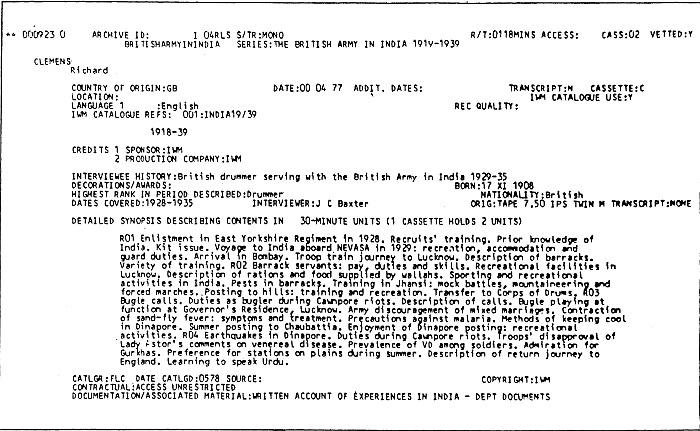Collections of oral history recordings
Case Study: Imperial War Museum, London, England.
(a) Collection
The Museum's collection comprises over 6,000 hours, 90% of which is speech, consisting mainly of oral history interviews conducted by Museum staff and of broadcast material. The remainder consists of music, sound effects, etc.
(b) Cataloguing Staff
Cataloguing is the primary responsibility of two graduate staff, who also have other duties; they receive advice from the Museum's Department of Information Retrieval. Occasional use is made of 'casual' staff (i.e. staff on short-term appointments), and increasingly of contributions to the documentation of their own interview material by oral history field workers (see gi below).
(c) Catalogue
Within the Museum, catalogue information is accessible on computer-output microfiches which replace a card catalogue. Catalogues to completed oral history projects (see gii) and to other coherent sub-collections are published as part of the Department of Sound Records' public service.
(d) Catalogue System
The sound records collection is included in the scope of the Museum's overall cataloguing policy. From 1977 to 1982, the collection was catalogued using a modified version of APPARAT, a computerised system developed by the Museum initially for its film collection. From 1983, all Museum cataloguing, including sound records, will use the computer package GOS developed by the Museum Documentation Association. Catalogue information is supplemented in some cases by transcripts and personal files.
(e) Indexes
GOS will be capable of maintaining a keyword subject index in addition to a combined index of people interviewed (including name changes etc.), and of generating other indexes at need. Short listings for completed oral history projects also provide a useful tool for visiting researchers.
(f) Example
See figure 1 for a sample entry from the APPARAT microfiche; entries were arranged in accession number order.
 Figure1
Figure1
(g) Comments
i. The number of cataloguers has not proved large enough to keep pace with the oral history acquisitions generated by the three interviewers on the Museum staff, and the freelance interviewers who are also employed. (There is of course also the non-oral history material). The two expedients mentioned in (b) above represent attempts to prevent the growth of a backlog of uncatalogued material.
ii. The Museum's oral history collection policy is geared to 'projects' of interviews on specific topics, and thus lends itself to the publication of catalogues to sub-collections. Compare with the relatively open-ended research orientation of, for example, the Welsh Folk Museum which forms the subject for the next case study.


